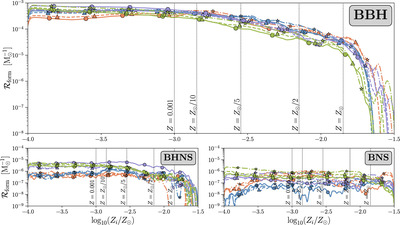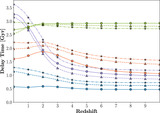Image Details

Caption: Figure 3.
The formation yield of BBHs, BHNSs, and BNSs that will merge within a Hubble time, per solar mass of star formation, ﹩{d}{{ \mathcal R }}_{\mathrm{form}}/{d}{M}_{\mathrm{SFRD}}﹩, as a function of birth metallicity, Z i , for all models. We choose initial metallicities for each binary by sampling randomly from a log-uniform metallicity distribution from Z i = 0.0001 to Z i = 0.03. We then obtain ﹩{{ \mathcal R }}_{\mathrm{form}}({Z}_{i})﹩ using a kernel density estimation over the initial metallicities of the simulated binaries. The decline in BBH formation efficiency at Z i ≳ Z ⊙/5 is clearly visible.
Copyright and Terms & Conditions
© 2024. The Author(s). Published by the American Astronomical Society.












